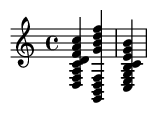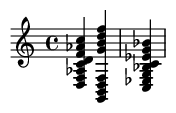What is the ii-V-I Progression? The Heartbeat of Jazz
The ii-V-I progression (pronounced "two-five-one") is more than just a sequence of chords; it's the fundamental grammatical sentence of jazz and tonal music. Found in countless standards, from "Autumn Leaves" to "All The Things You Are," its power lies in creating a compelling journey of tension and release. Understanding this progression is your gateway to speaking the language of jazz fluently.
The Anatomy of a Major ii-V-I
Let's build a ii-V-I from the ground up in the key of C Major. The Roman numerals refer to the scale degrees of the major scale (C-D-E-F-G-A-B). We build seventh chords on the second (ii), fifth (V), and first (I) degrees:
- ii (D): Dm7 (D-F-A-C) - A minor seventh chord, serving a subdominant function. It sets up the tension.
- V (G): G7 (G-B-D-F) - A dominant seventh chord, serving a dominant function. This is the point of maximum tension.
- I (C): CMaj7 (C-E-G-B) - A major seventh chord, serving a tonic function. This is our home base, the point of resolution.
Here is the progression in its most basic form:

Smooth Voice Leading: The Key to a Professional Sound
The true beauty of the ii-V-I lies in its efficient voice leading. The notes move by the smallest possible distance, creating a seamless, flowing sound. The most important notes to track are the guide tones (the 3rd and 7th of each chord) , which carry the core harmonic information.
Observe the guide tone movement in C Major:
- Dm7: The guide tones are F (the 3rd) and C (the 7th).
- G7: The F stays as the 7th, and the C moves down a half-step to B (the 3rd). This creates a powerful tritone interval (F-B) that begs for resolution.
- CMaj7: The F resolves down a half-step to E (the 3rd), and the B stays as the 7th.
This minimal movement is what gives the progression its satisfying and logical feel. Here is an example of a common, voice-led piano voicing:
The Minor ii-V-i: Adding a Touch of Melancholy
In a minor key, the progression changes character. We use the harmonic minor scale to build the V chord, which gives us a leading tone and a stronger pull to the tonic. This transforms the progression into iiø7-V7-i.
- iiø7 (ii m7b5) : The ii chord becomes a half-diminished chord (minor third, diminished fifth, minor seventh). In C minor, this is Dm7b5 (D-F-Ab-C).
- V7: The V chord remains a dominant seventh, but is often altered (V7alt) in jazz to create even more tension. We'll use a standard G7 (G-B-D-F).
- i: The tonic chord is a minor or minor-major seventh chord, such as Cm7 (C-Eb-G-Bb).
Here is a minor ii-V-i in C minor:

Creative Variations: The Tritone Substitution
Once you're comfortable with the basic form, you can explore substitutions. The most common is the tritone substitution, where the V7 chord is replaced by a dominant seventh chord a tritone away. In C Major, instead of G7, we can use Db7.
Why does this work? G7 and Db7 share the same guide tones (F and B/Cb) ! This allows you to create a smooth, chromatic descending bass line (D - Db - C) while maintaining the harmonic function.

Where to Find the ii-V-I in Your Favorite Songs
The ii-V-I is everywhere! Listening for it is a great way to train your ear.
- "Autumn Leaves": A perfect study piece, filled with both major and minor ii-V-I's.
- "Fly Me to the Moon": The opening line is a journey through descending ii-V's.
- "Satin Doll": Features a classic repeated ii-V pattern in the A section.
- "Tune Up": This Miles Davis tune is a great workout, as it consists of ii-V-I's in three different keys.
- "All The Things You Are": A masterclass in using ii-V's to modulate between different key centers.
How to Practice the ii-V-I Progression
Mastering this progression requires dedicated practice. Here’s a step-by-step approach:
- Play in All 12 Keys: This is non-negotiable. Start by playing the root position chords, then move to voice-led versions. The goal is instant recall.
- Isolate the Guide Tones: Play just the 3rds and 7ths of each chord. Hear how they move and resolve. This is the skeleton of the progression.
- Improvise Using Arpeggios: Play the notes of each chord (D-F-A-C over Dm7, etc.) to outline the harmony clearly.
- Improvise Using Scales: Use the corresponding scale for each chord (e.g., D Dorian for Dm7, G Mixolydian for G7, C Ionian for CMaj7).
- Learn Licks and Phrases: Transcribe how your favorite jazz musicians navigate the ii-V-I. Learn their vocabulary and adapt it to your own playing.
- Experiment with Substitutions: Once you're solid, start incorporating variations like the tritone substitution to add color and sophistication.
The ii-V-I is a deep well of harmonic possibility. By breaking it down, practicing it diligently, and listening for it in the music you love, you'll unlock a new level of understanding and expression in your playing.
